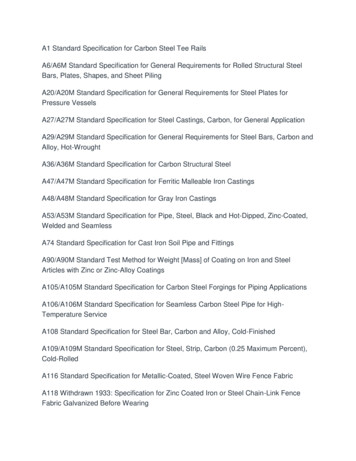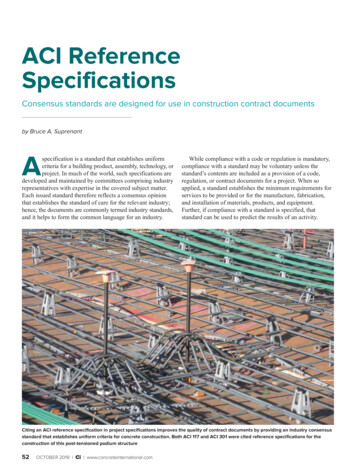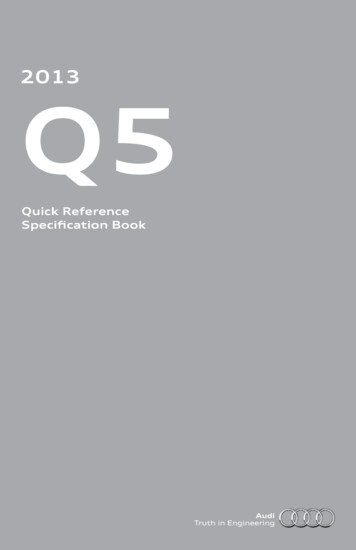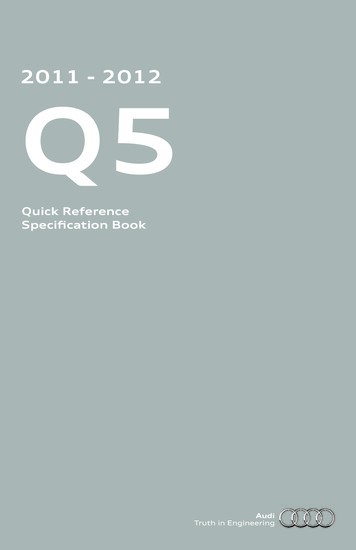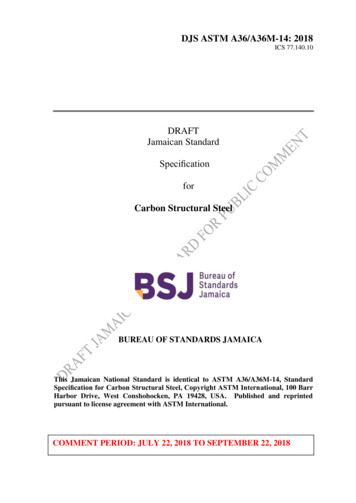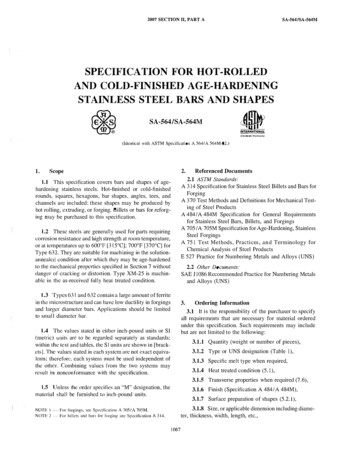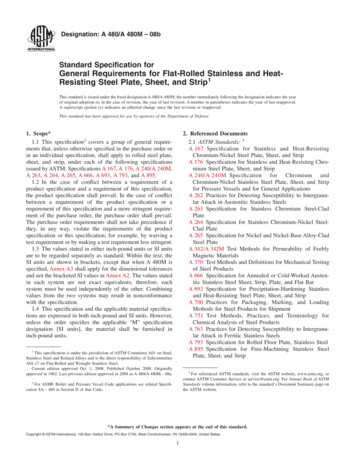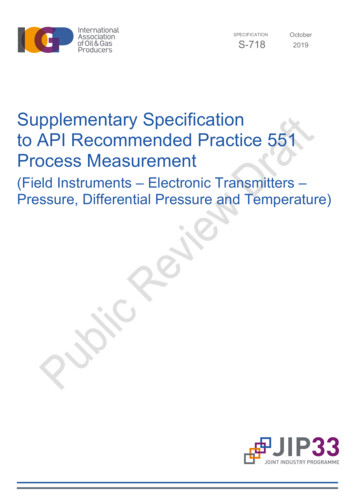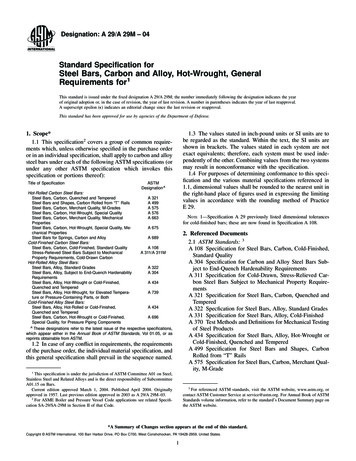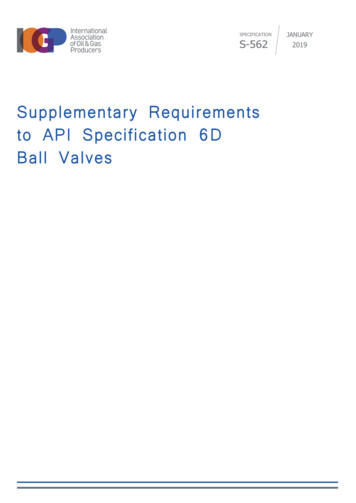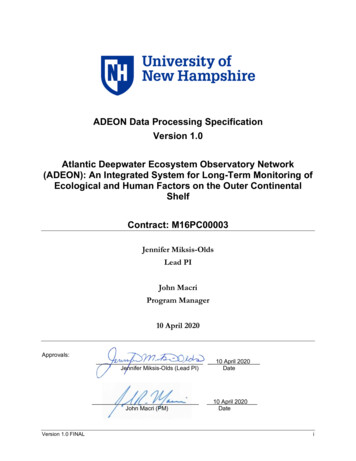
Transcription
ADEON Data Processing SpecificationVersion 1.0Atlantic Deepwater Ecosystem Observatory Network(ADEON): An Integrated System for Long-Term Monitoring ofEcological and Human Factors on the Outer ContinentalShelfContract: M16PC00003Jennifer Miksis-OldsLead PIJohn MacriProgram Manager10 April 2020Approvals:10 April 2020Jennifer Miksis-Olds (Lead PI)DateJohn Macri (PM)Version 1.0 FINAL10 April 2020Datei
ADEON Data ProcessingSpecificationAuthors:Kevin HeaneyBruce MartinJennifer Miksis-OldsTim MooreJoseph WarrenMichael Ainslie9 April 2020Version 1.0 FINALVersion 1.0 FINALi
Suggested citation:Heaney, K., Martin, B., Miksis-Olds, J., Ainslie, M., Moore, T., and Warren, J. 2020. ADEONData Processing Specification, Version 1.0 FINAL. Technical report by Applied Ocean Sciencesfor Prime Contract No. M16PC00003.Disclaimer:The information presented herein is relevant within the specific context described in this report.It could be misinterpreted if not considered in the light of all the information contained in thisreport and other ADEON documents. Accordingly, if information from this report is used indocuments released to the public or to regulatory bodies, such documents must clearly cite theoriginal report, which shall be made readily available to the recipients in integral and uneditedform.Table of Contents1. Introduction . 2ADEON Project. 2Objectives. 2ADEON Project Objectives . 2ADEON Standardization Objectives . 3Data Processing Specification Overview . 3Scope of Phase III (Data Processing) . 3List of Products from Phase III . 4Data processing products . 4Supporting Documentation and Standards . 52. Passive Acoustic Data Recorders . 6Remotely Deployed Passive Acoustic Data Recorders . 6Quantitative Soundscape Metrics . 6Qualitative Soundscape Metrics . 9Biological sources . 9Click Detection . 9Tonal Call Detection. 11Validation of Automated Detectors . 13Manmade sources . 14Vessel Detection . 14Airgun Pulse Event Detection . 15Impulse Detector . 16Geophysical sources. 16Source Directionality . 16Passive Data Recorder Analysis Implementation Overview and Outputs . 17Passive Data Recorder Analysis Implementation. 17Level 0 Data Products . 18Level 1 Data Products . 18Level 2 Data Products . 18Level 3 Data Products . 20Towed Array Passive Acoustic Data Recorders . 21Processing Steps . 21Examples . 26Level 0 Data Products . 30Level 1 Data Products . 30Version 1.0 FINALi
ADEON Data Processing SpecificationLevel 2 Data Products . 303. Active Acoustic Recorders . 33Processing of data from remotely deployed echosounder systems . 33Level 0 Data Products . 33Level 1 Data Products: Importing binary files directly into Echoview . 33Level 2 Data Products: Processing Echoview files. 34AZFP Temperature Processing . 35Processing of data from vessel-mounted echosounder systems . 35Level 0 Data Products . 35Level 1 Data Products: Importing binary files directly into Echoview . 35Environmental parameters . 36System and calibration settings . 36Transducer geometry settings . 36Time settings . 36Level 2 Data Products: Processing Echoview files. 36Construct a Surface Exclusion Line . 37Detect the bottom and construct a bottom exclusion line . 37Removal of bad data regions . 37Remove ambient noise . 37Remove self-noise . 37Set a Sv or TS threshold . 38Set the size of the analysis cell. 38[Optional] Identification of specific scatterers (species or other groups) . 38Export integrated backscatter and TS data . 38Examine data outputs . 38Analyze the data . 39Estimate uncertainty . 39Cross-calibration with remotely deployed echosounder systems . 394. Conductivity, Temperature, Dissolved Oxygen (CT-DO) Loggers . 405. VEMCO VR2-W Fish Tag Loggers . 416. ADEON Satellite Data Set Processing . 42Global gridded data sets . 42NASA JPL Sea Surface Temperature . 43Net Primary Productivity . 45Mixed Layer Depth . 46Precipitation Data . 47Altimetry Data . 47Wind Speed and Stress . 48Surface Currents . 49Local Real-time NASA satellite data. 49RTOFS data . 51File Formats and navigations for ADEON satellite data sets . 52Additional resources . 53Acronyms . 54Bibliography . 57Version 1.0 FINALii
ADEON Data Processing SpecificationFIGURESFigure 1. ADEON Quantitative soundscape metrics processing block diagramFigure 2. The click detector/classifier block diagramFigure 3. Illustration of the search area used to connect binary spectrogram binsFigure 4. Example of system-weighted and 40–315 Hz band SPL, as well as the number oftonals detected per minute as a ship approached a recorder, stopped, and then departedFigure 5. Overview of the data files, data analysis software, and output files associated with thepassive acoustic data recorder analysisFigure 6. Per-recorder subfoldersFigure 7. Per-sampling rate results directory contents.Figure 8. Processing steps for computing frequency domain power from the element timeseries. The L0 input is x(t). The L2 output is P(f).Figure 9. Processing steps for the frequency domain plane wave beamformer mapping theelement complex pressure in a frequency bin to the beam power (vs. angle) of that frequencybin.Figure 10. Processing steps computing the decidecade sound exposure level (integratedpower) for each beam across the band.Figure 11. The time series p(t) for 1 second of data from Channel 8 on Jun 2, 2018. The unitsare in Pa. The Hann weighted signal is plotted in blue.Figure 12. Fast Fourier Transform (FFT) 𝐿𝑓 re 1 uPa 2/Hz for 1 Hz frequency resolutionand 1 s time duration.Figure 13. A 1-minute spectrogram, L B (re 1 uPa 2 s/(Hz) vs time and frequency, in decibels,generated by stacking 60 one-second FFTs for a single channel.Figure 14. Conventional Beam Former (CBF) responses (Power in dB of B(f, ))for a 1-s p(t)snapshot.Figure 15. Filename convention for the JPL global 1km SST product produced by the GHRSSTproject.Figure 16. Filename convention for NASA 8-day chlorophyll product from SNPP- GHRSSTproject.Figure 17. Filename convention for daily global GPM precipitation data from NASA.Figure 18. Filename convention for daily global FSLE altimetry data from AVISO.Figure 19. Defined region (black lines) for acquiring real-time NASA CHL and SST dataFigure 20. Filename convention for daily NASA real-time daily Level 2 dataFigure 21. Filename convention for daily RTOFS real-time 6-hourly dataFigure A1. A sample Deployment Info File from the fictitious 2016‐10 deployment (described inSection 1.1.1.1.1.A.1.2), viewed in Notepad without word wrapFigure A2. A sample Deployment Info File from the fictitious 2016‐10 deployment (described inSection 1.1.1.1.1.A.1.2), viewed in ExcelFigure A3. Data folder structures for two example deployments – 2016-10 and august2011Figure A4. Signal data acquisitionVersion 1.0 FINALiii
ADEON Data Processing SpecificationFigure B1. “Variable Properties” option within the echogramFigure B2. Screenshot of time/distance grid in EchoviewFigure B3. Screenshot of analysis Menu in EchoviewFigure B4. A 30 minute, 5 meter gridded echogramFigure B5. Screenshot of integration option in EchoviewTABLESTable 1. Specification of ADEON data processing levels compared with those of IFREMER andNASA.Table 2. Fast Fourier transform and detection window settings used to detect tonal calls of marinemammal species expected in the data.Values are based on JASCO’s experience and empirical evaluation on a variety of datasetsTable 3. Call sorter definitions for the tonal calls of cetacean species expected in the areaTable 4. Effects of changing the F-score β-parameter on the classification threshold, precision,and recall for the odontocete clicksTable 5. Decidecade limits and center frequencies for index n from -10 to 0.Table 6. Selected data export packages from conditioned Echoview dataTable 7. Naming convention key for exported .csv files from Echoview.Table 8. Global gridded satellite/model product characteristics for ADEONTable 9. Satellite product names and units for ADEONTable 10. Data file variables for daily ASCAT Wind netCDF files from IFREMERTable 11. Products and data objects for Level 3 and 4 global filesTable A1. Fields of the deployment summary lineTable A2. Fields of the recorder line(s)Table A3. Decade band SPL valuesTable A4. ACI header valuesTable B1. Bin depths and time averages of exported dataVersion 1.0 FINALiv
ADEON Data Processing Specification1. IntroductionADEON ProjectThe Atlantic Deepwater Ecosystem Observatory Network (ADEON) for the US Mid- and SouthAtlantic Outer Continental Shelf (OCS) has been developed and was deployed in fall 2017. Thelead principal investigator (PI) for this project is Dr. Jennifer Miksis-Olds, University of NewHampshire (UNH). Dr. Miksis-Olds leads a collaborative research team consisting of individualsfrom Applied Ocean Sciences, UNH, JASCO, Stony Brook University, Florida AtlanticUniversity, NOAA’s Southwest Fisheries Science Center, OASIS, and TNO.This observatory network is generating multi-year measurements of the natural and humanfactors active in this region, thus informing the ecology and soundscape of the OCS. Long-termobservations of living marine resources and marine sound will assist federal agencies, includingthe Bureau of Ocean Energy Management (BOEM), the Office of Naval Research (ONR), andthe National Oceanic and Atmospheric Administration (NOAA), in complying with mandates inthe Endangered Species Act (ESA), Marine Mammal Protection Act (MMPA), and SustainableFisheries Act (SFA).ObjectivesADEON Project ObjectivesThe ADEON project objectives are to: Establish an ecosystem observation network that provides baseline monitoring and supportspredictive modeling of the soundscape and its relationship to marine life and theenvironment of the Mid- and South Atlantic Planning Areas. Develop standardized measurement and processing methods as well as visualizationmetrics for comparing ADEON observations with data from other monitoring networks. Assess baseline soundscape and ecosystem conditions in support of predictiveenvironmental modeling and trend analyzes in the planning areas. oHow do soundscape and ecosystem components vary with water depth across theOCS?oHow do the soundscape and ecosystem components vary with latitude along the OCS?oWhere are the hot spots of human activity that impact ecosystem/habitat health impacts?Assess the spatial and temporal distribution of the soundscape and biological scatterers,including their expected variation and correlation with distance from the bottom landerlocations.o What are the environmental factors that define and constrain the horizontal range ofappropriate extrapolation of observations measured at the stationary bottom landersites?Develop and apply new methods to effectively visualize five-dimensional (5D–time, latitude,longitude, frequency, and depth) soundscape data with interactive visual analysis tools thatVersion 1.0 FINAL2
ADEON Data Processing Specificationenable users to explore, analyze, and integrate ancillary ecosystem data streams with the5D soundscape. Develop a robust data management system that archives and provides public access tomultiple data streams to encourage future development of ecological models targeted atquestions beyond the scope of this study.ADEON Standardization ObjectivesThe ADEON standardization objectives are: Ensure compatibility within ADEON between soundscapes based on measurements andthose based on models. Ensure compatibility between measurement data from different researchers or instituteswithin ADEON. Facilitate compatibility between ADEON soundscapes, whether based on measured ormodeled prediction, and soundscapes produced by a hypothetical future or parallel projectwithin the US EEZ. Facilitate compatibility between metrics used to quantify ADEON soundscapes and thoseused to monitor ambient sound in the context of the EU’s MSFD (Marine StrategyFramework Directive).This report, the Data Processing Specification, is the fourth of five Standardization reports,which together meet the above four objectives. The ADEON project has implemented anautonomous ocean observatory that includes multiple hardware components. This reportdescribes the measurements taken and details the specific steps taken to go from rawobservations to the analysis results and ADEON data that is archived and made available to thepublic.Data Processing Specification OverviewIn presenting the data processing used for each of the input data sensors and streams in theADEON project, it may be useful to consult a list of the ADEON Hardware which is specificallylisted in the Hardware Specification Guide.Scope of Phase III (Data Processing)One objective of the ADEON Data Processing Specification (DPS) is to define the discrete stepstaken during Phase III (Data Analysis) that took the raw data (Level 0) and mapped it into a formwhich was then distributed amongst the ADEON team for soundscape and ecosystem analysisand synthesis (Phase IV), archived by the University of New Hampshire, and made available tothe public. Each system recorded machine-readable raw data that must, in many cases, beprocessed to calibrated time series (Level 1). This procedure usually included some form oferror checking or filtering, some form of statistical or spectral processing, and some form ofaveraging. The resulting files (Level 2) are then useful to the wider community. Depending uponthe level of aggregation, some of the products can reach a maturity of Level 3 and beyond(Table 2).Version 1.0 FINAL3
ADEON Data Processing SpecificationTable 2. Specification of ADEON data processing levels (column 4) compared with those of IFREMER (column 2) and NASA (column 3).NASA2level IFREMER1ADEON0This so-called instrumental level corresponds Reconstructed, unprocessed instrument andraw, uncalibrated datato the raw data at full resolution emitted by payload data at full resolution, with any and allExamples: binary AZFP files and .wavthe sensor. The data are time-ordered butcommunications artifacts (e.g., synchronizationfiles before the calibration information isare not always expressed in standardisedframes, communications headers, duplicate data)appliedunits. This is why archiving at this level isremoved. (In most cases, the EOS Data andneither systematic nor permanent.Operations System (EDOS) provides these data tothe data centers as production data sets forprocessing by the Science Data ProcessingSegment (SDPS) or by a SIPS to produce higherlevel products.)calibrated times series data.1For this intermediate level, data are time1A: Reconstructed, unprocessed instrument dataExamples: Data processed usingat full resolution, time-referenced, and annotatedreferenced and converted into units thatcomply with international standards.with ancillary information, including radiometric and Echoview software, after calibration isapplied (Sv); sound pressure on aInstrumental specificities and errors may also geometric calibration coefficients andstationary or moving platformbe corrected. Recent instrumental systemsgeoreferencing parameters (e.g., platformdirectly provide data at this level.ephemeris) computed and appended but notapplied to Level 0 data.212Level 2 data, at georeferenced geophysicallevel, are dated, spatially located andorganised in a format that facilitates theirscientific usage. Variations related to theacquisition conditions are also corrected andthe data are thus expressed in a referencesystem that is independent of themeasurement platform.1B: Level 1A data that have been processed tosensor units (not all instruments have Level 1Bsource data).Derived geophysical variables at the sameresolution and location as Level 1 source data. egremove atmosphere; derive productExamples: decidecade levels; SEL;depth-integrated Sv; beamformed data(individual sensors on an array aretreated as if they were at one singlelocation or ng-levels-for-eosdis-data-productsVersion 1.0 FINALThe first level of processed data fromthe calibrated data. Only quantitative(temporal or spatial) processing.1
ADEON Data Processing SpecificationIFREMER1Level 3 data are presented in relation toidentical and standardised space-timereference scales. The data can thereby beeasily compared and aggregated, includingbetween different measurement programmesNASA2Variables mapped on uniform space-time gridscales, usually with some completeness andconsistency.4This level consists of interpolated data,resulting from data analysis.Model output or results from analyses of lowerlevel data (e.g., variables derived from multiplemeasurements). eg primary productivity5This level refers to synthesis products.level3ADEONSecond order processing, includingsome qualitative information.Examples: Whale or ship detections;products related to classification ofsignals; products related to signallocalizationInterpolated productsExample: density estimationSynthesized products related tosoundscape models/maps and predictivehabitat modelling.requires additional information (eg AIS,source model)Version 1.0 FINAL2
ADEON Data Processing SpecificationAn example of this processing stream is the soundscape percentiles generated from thehydrophone data collected on the bottom-lander omni-directional hydrophones. The acoustictime series, digitized from the voltage changes of the hydrophone, are the raw Level 0 data.This was then band-passed (outlier rejection) and a calibrated time series generated (Level 1).The data were then processed for quantitative soundscape metrics (Level 2) such as the level indecidecade3 bands or the peak sound pressure level. Event detection and classification ofsignals, such as marine mammals and ships, were presented below but this is considered Level3 data. The work of Phase IV may include longer-term averages, but statistics of these averagesare considered a use of the processed data and are beyond the scope of this document.The satellite data aggregated by Dr. Tim Moore and the team at the University of NewHampshire and Florida Atlantic University is included in the DPS for completeness, although itdoes not involve data processing as outlined above. There was significant effort put forward bythe global remote sensing (satellite) community to generate products. These products weregenerally received in either Level 3 or Level 4. Their description in this document is suitablebecause this is the position in the analysis where they will be distributed to the ADEON scientificteam (for Phase IV analysis), archived by the University of New Hampshire, and then distributedto the public.A second objective is to document detailed processing for soundscape metrics of the ADEONSoundscape Specification (Ainslie et al., 2018). This second objective is met by Section 2,which for this reason has more detail than other parts of this report.The terminology follows ISO 18405 (ISO, 2017) and the ADEON Terminology Standard (Ainslieet al 2017b).List of Products from Phase IIIThe successful execution of Phase III led to an extensive set of data products for analysis.These include:1. Passive acoustic data from bottom lander moorings (Section 2.1)2. Passive acoustic data from the towed array sensor (Section 2.2)3. Active acoustic data from remotely deployed echo sounder systems (Section 3.1)4. Active Acoustic data from mounted echo sounder systems (Section 3.2)5. Satellite Data Set Processing (Section 5)Data processing productsFollowing the NASA guidelines for data products, the data were categorized based upon theamount of processing and additional information used to generate the resulting processingproduct. Raw electronic measurement data, usually digitized in non-dimensional bits from ananalog-to-digital processor of some kind is referred to as Level 0 (L0) data. This is often the3A decidecade is one tenth of a decade. One tenth of a decade is approximately equal to one third of anoctave. For this reason, a decidecade is sometimes referred to as a “one-third octave”.Version 1.0 FINAL4
ADEON Data Processing Specificationoutput of a measurement device and is what is recorded on hard-disks as .wav files (for audio).The Level 1 (L1) product was generated by mapping of these bits to a physical quantity, with theapplication of a calibration factor (going from bits to volts (V) and then on to pascals (Pa) foracoustic signals) and the inclusion of a time-stamp and sample rate. For processing software,as in the Active Acoustic measurements in Section 3, this was often done within the processingsuite and is not visible to the user. Level 2 (L2) data were generated when the L1measurements were processed directly with no additional information. For the passive acousticprocessing these products were the decidecade band sound level within a specified time period(1 s). Inclusion of ancillary such as location, ship speed, temperature/salinity (for acoustic traveltime) in the processing produces a Level 3 data product.Supporting Documentation and Standards1. Acoustical terminology follows ISO 18405, supported by Ainslie et al (2017). The JIP dataprocessing standard (Ainslie et al., 2018c) is followed.Version 1.0 FINAL5
ADEON Data Processing Specification2. Passive Acoustic Data RecordersThe objective of this section is to define the characteristics of passive acoustic data recordersthat are essential for accurately measuring soundscapes.Remotely Deployed Passive Acoustic Data RecordersThe ADEON Soundscape Specification (Ainslie et al., 2018b) documents the quantitative andqualitative metrics for describing the soundscape. This section contains block diagrams andexplanations of the data processing algorithms used to generate those metrics. Descriptions ofkey file formats used in the analysis and for data outputs are contained in Appendix A.Quantitative Soundscape MetricsTable 2 from the Soundscape Specification (Ainslie et al., 2018b) defines the SnapshotDurations (duration over which data are integrated) and Data Analysis Durations (duration overwhich data are reported) for six quantitative soundscape metrics:1. Lp, t : The sound pressure level over the period t;2. Lpk, t : The peak sound pressure level recorded over t;3. Lp,ddec, t : The sound pressure level in decidecade bands over the period t; this includesdecade and multidecade bands;4. β t: The sound pressure kurtosis (tailedness of distribution) over the period t;5. LE,ddec,24h: The 24 -hour sound exposure level in decidecade bands; and6. LE,w,24h: The 24 -hour weighted sound exposure level, weighted by the marine mammalhearing group functions ([NMFS] National Marine Fisheries Service (US) 2016) orselected marine mammal audiograms.The durations of the temporal observation window (TOW) and temporal analysis window (TAW)were 1 and 60, s, 1 h, 1 d, 1 mo, and 1 a (Ainslie et al, 2018b). The definitions of one month (1mo) and one year (1 a) correspond to calendar months (28, 29, 30, or 31 days) and calendaryears (365 or 366 days). For kurtosis estimates only 60 s is computed (based on Martin et al.(2020, in press). For the sound exposure levels, the TOW duration is always 1 d and the TAWdurations is either 1 mo or 1 a. For combinations of TOW and
Figure 14. Conventional Beam Former (CBF) responses (Power in dB of B(f, ))for a 1-s p(t) snapshot. Figure 15. Filename convention for the JPL global 1km SST product produced by the GHRSST project. Figure 16. Filename convention for NASA 8-day chlorophyll produ
